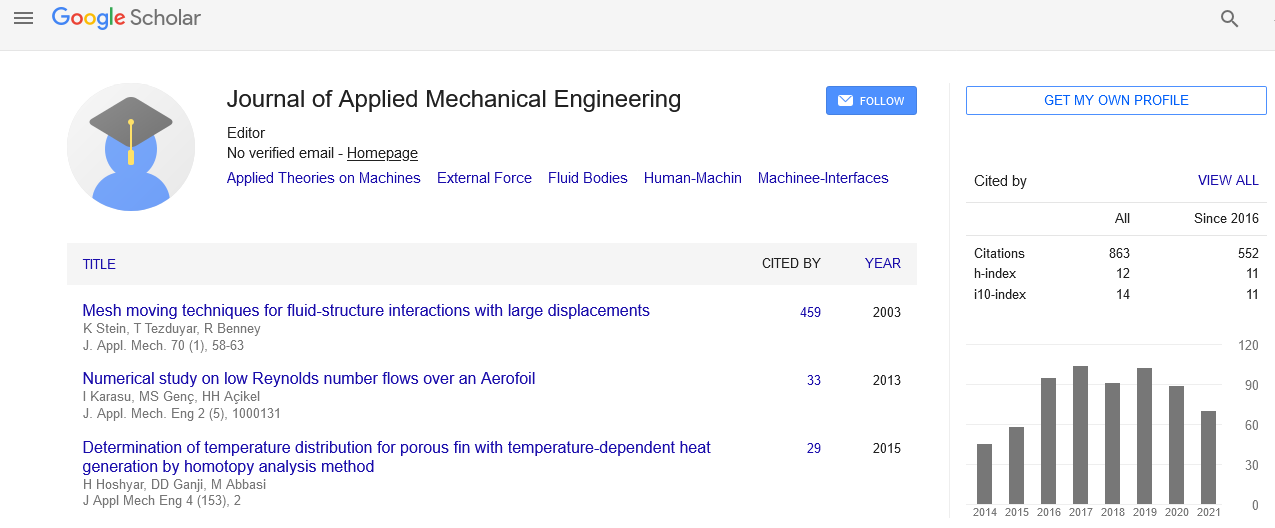Indexed In
- Genamics JournalSeek
- JournalTOCs
- CiteFactor
- RefSeek
- Hamdard University
- EBSCO A-Z
- OCLC- WorldCat
- Publons
- Google Scholar
Useful Links
Share This Page
Journal Flyer

Open Access Journals
- Agri and Aquaculture
- Biochemistry
- Bioinformatics & Systems Biology
- Business & Management
- Chemistry
- Clinical Sciences
- Engineering
- Food & Nutrition
- General Science
- Genetics & Molecular Biology
- Immunology & Microbiology
- Medical Sciences
- Neuroscience & Psychology
- Nursing & Health Care
- Pharmaceutical Sciences
Perspective - (2023) Volume 12, Issue 1
Modeling of Planar Multiple Jointed Kinematic Chain and Mechanisms
Tokede Deschner*Received: 02-Jan-2023, Manuscript No. JAME-23-20843; Editor assigned: 05-Jan-2023, Pre QC No. JAME-23-20843; Reviewed: 19-Jan-2023, QC No. JAME-23-20843; Revised: 26-Jan-2023, Manuscript No. JAME-23-20843; Published: 03-Feb-2023, DOI: 10.35248/2168-9873.23.12.461
Description
Design, in general terms, may be considered as the process of creating solutions that will give shape to the final products or systems in conformance to the requirements of customer. While encountering a design problem, we tend to utilize our skills, available information and put our knowledge to the problem set in order to fully understand the problem and to generate feasible and optimum solutions. The next step includes evaluation of applied concepts with regard to requirements of the customers and selecting the most validated concept for design analysis and optimization. In other words, design may be considered as mapping of the requirements of customers in the form of a physical manifestation. This demands better understanding of the problem and keeping in view the various aspects of customer’s requirements.
As far as the designing and modeling of kinematic chains and mechanisms is considered, there are various techniques which have been developed after years of rigorous work undertaken by various scientists and engineers which are very effective in the development and identification of various identical and as well as distinct multiple jointed kinematic chains like Generalized Matrix Notation, Transformation of links, Adjacency Matrix, Distance matrix etc. to determine structurally identical and distinct kinematic chains and mechanisms. Lately, a novel approach has evolved for abstractly representing a kinematic structure, that is akin to symbolic depiction of chemical compounds. Since a kinematic assembly or structure consists of crucial information about different types of links, the connection amongst them and the types of different joints, hence it is found to be more convenient to represent a kinematic structure by means of a graph which provides ease for systematic inventory using various mathematical tools and computer algorithms along with combinatorial analysis.
A design methodology mandates use of concepts of graph theory and combinatorial analysis in conjunction with mathematical tools and computer algorithms for designing kinematic structures e.g., distinct kinematic chains and mechanisms. The foremost step includes identification of the functional requirements pertaining to various class of kinematic chains and mechanisms. Second step involves systematic enumeration of those kinematic structures exhibiting similar nature by making use of graph theory techniques, computer algorithms and combinatorial analysis.
Conclusion
Further, keeping in mind the potential of each kinematic structure in meeting the functional requirements, each such structure is sketched and qualitatively evaluated. Final step involves selection of an optimum concept for design optimization, dimensional synthesis, simulation, and demonstration of prototype. It may be defined as the study of motion but not taking into account the forces that have caused the motion. The field of Kinematics related to machines deals with the relative motion of machine components. A study of position, displacement, velocity including acceleration of machine components is carried out. If all the points of a body move in such a way that they are parallel with regard to some reference plane, then the body is said to be in plane motion.
Citation: Deschner T (2023) Modeling of Planar Multiple Jointed Kinematic Chain and Mechanisms. J Appl Mech Eng. 12:461.
Copyright: © 2023 Deschner T. This is an open-access article distributed under the terms of the Creative Commons Attribution License, which permits unrestricted use, distribution, and reproduction in any medium, provided the original author and source are credited.

